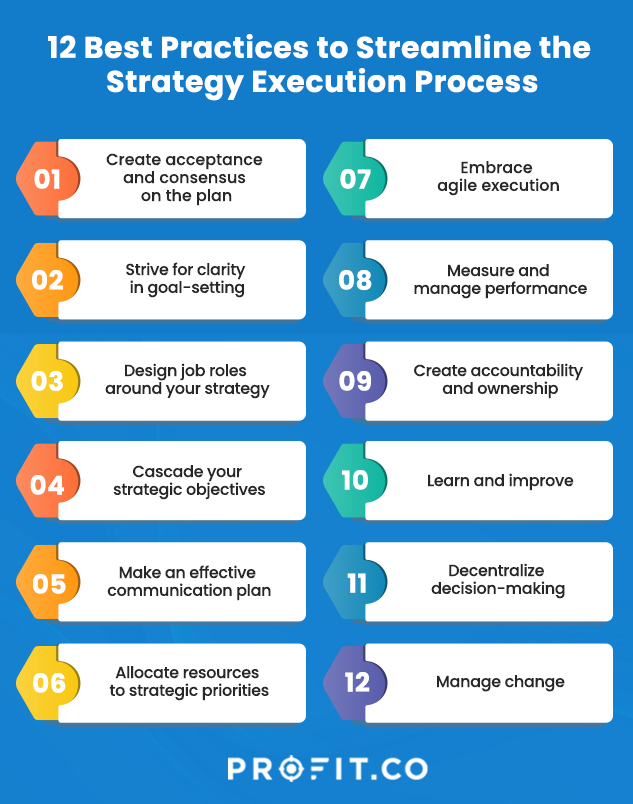Introduction
In a highly competitive and volatile business landscape, strategic execution has been a differentiating factor in the success of organizations. A solid strategic plan lays the foundation for achieving the organizational objectives, but the strategy execution process poses numerous challenges in bringing the strategy to fruition. Despite having robust strategic plans, many companies struggle to implement them effectively. So there is a significant gap between the strategic plan and the strategy execution.
There are a multitude of reasons for the gap in strategy execution.
- Strategy execution requires a collective, coordinated effort from all levels of the organization. So you must effectively communicate and impart a uniform understanding of the strategy to achieve active engagement from employees at every level. However, when the business environment, market conditions, and customer preferences go through frequent seismic shifts, it poses a massive challenge to seamless strategy execution.
- The strategy execution process must translate the strategic plan into actionable steps, complement it with appropriate resource allocation, and implement changes to manage unforeseen challenges. It calls for agility at the organizational level, strong leadership to steer the entire organization in the right direction, effective project management, and a culture of ownership and accountability toward strategic objectives and initiatives. However, strategy execution often suffers from a lack of communication and coordination, employees working in silos, rigid bureaucratic structures, and resistance to change.
- The strategic execution process hits obstacles when the employees struggle to balance fulfilling operational obligations and focusing on long-term strategic priorities. Lack of focus on strategic objectives can result in a disjointed strategy execution process, creating a gap between plan and strategy execution.
The solution to these challenges in strategy execution lies in streamlining the strategy execution process.
Without strategy, execution is aimless. Without execution, strategy is useless.
Streamlining the Strategy Execution Process
Making the strategy execution effective and less susceptible to gaps in implementation requires streamlining the strategy execution process. You can achieve that by implementing a few best practices that improve focus and alignment, enhancing the ability of the organization to achieve strategic goals. These practices create a more agile and responsive environment, make the organization adaptable, flexible, and innovative, and help the organization thrive and prosper in a challenging and fast-evolving business landscape.
12 Best Practices to Streamline the Strategy Execution Process

Streamlining a strategy execution process is a continuous journey.
Following are some of the best practices that can help organizations streamline their strategy execution process:
1. Create acceptance and consensus on the plan
Before even initiating the strategic execution process, it is indispensable to get the support and approval of the strategic plan from all the stakeholders. When there is consensus, you have a team prepared to work towards a common purpose, and it will be easy to achieve alignment with strategic objectives during the implementation phase.
2. Strive for clarity in goal-setting
Goal-setting should align with the organization’s strategic objectives at all levels, and the goals should be SMART – Specific, Measurable, Achievable, Relevant, and Time-bound. You can ensure alignment by providing clarity on those objectives throughout the organization to all the employees using effective communication.
3. Design job roles around your strategy
You must create jobs that fulfill your strategic objectives rather than prioritizing operational obligations. If you have job descriptions designed around the strategy, you will automatically get the right people for strategy execution.
Bridge the Strategy Execution Gap with Profit.co
4. Cascade your strategic objectives
As long as your strategic objectives remain in intent and not in practice, there won’t be any progress in strategy execution. It is essential to break down the overarching strategic objectives into smaller, actionable, SMART goals for each department and team. You can use a goal-setting framework like Objectives and Key Results (OKR) to set SMART, actionable goals at the managerial level and cascade them throughout the organization so that they filter down to the last level, ensuring alignment and coordination.
5. Make an effective communication plan
The strategic plan must reach all levels of the organization. You must create a robust communication plan to effectively share the strategic plan, objectives, expected outcomes, progress updates, and changes. You must create a culture of transparency and open communication to ensure uniform understanding, engagement, and buy-in from all stakeholders.
6. Allocate resources to strategic priorities
A strategic plan should be accompanied by effectively allocating financial, human, and technological resources to achieve the strategic priorities.
7. Embrace agile execution
Agile methodologies and practices give you the flexibility and decision-making abilities essential for quickly adapting to changing market conditions and tackling unforeseen challenges.
8. Measure and manage performance
You must identify the right metrics and KPIs to measure the performance and effectiveness of the strategy execution process. You should also implement a robust performance measurement system to periodically monitor and evaluate the strategy execution and identify areas for improvement.
9. Create accountability and ownership
Setting the expectations for every individual involved and assigning tasks and expected outcomes from them fosters a culture of accountability and ownership. Create an organizational culture that encourages individuals and teams to take responsibility for their tasks and the outcomes.
10. Learn and improve
It is essential to collect data, track key metrics, assess performance, and draw inferences from the strategy execution so that you can learn from it, document these findings, and disseminate the reports to promote a culture of continuous learning, innovation, and improvement across the organization.
11. Decentralize decision-making
Encourage autonomous decision-making at all levels and empower the employees to make decisions appropriate to their level, in line with the strategic objectives. Promote decentralization of decision-making and empower the employees to independently make decisions and collectively respond to emerging opportunities and imminent challenges.
12. Manage change
Organizational change is integral to the strategy execution process. But changes are often accompanied by resistance and skepticism. Adopt effective change management practices to proactively address resistance, explain the benefits of the change, and the importance of everyone’s contribution to the overall strategy. Communicate the need for change, convince the stakeholders to buy in, and provide training and support to employees during the strategy execution process.
FAQs
1. What are the five processes of making and executing a strategy?
The five processes of making and executing strategy are:
- Strategy analysis: Understanding the current state of the internal and external environment of the organization, doing SWOT analysis, market research, competitor analysis, and taking an audit of the skills, capabilities, and resources of the organization.
- Formulating strategy plans: Collect all the necessary information to develop strategic objectives and make strategic decisions, including selecting target markets, product offerings, branding and positioning, and resource allocation.
- Strategy execution: Converting the strategic plans into a plan of execution with actionable steps, timelines, schedules, budgets for various tasks and activities, communication, coordination, alignment, and management of plan implementation.
- Measuring performance: Monitoring the effectiveness of the strategy execution process by tracking relevant KPIs, gaining insights from them, and identifying gaps and need for adjustments.
- Adapting and managing change: Monitoring the effectiveness of the outcomes of the strategy, collecting feedback from stakeholders, and tracking the factors that influence the strategic and organizational performance; making adjustments and responding to external and internal challenges.
2. What are the steps in strategy execution?
Strategy execution involves:
- Goal-setting
- Developing an action plan
- Resource allocation
- Communication and achieving alignment
- Monitoring progress
- Evaluation
- Adjusting and change management
- Fostering a culture of accountability
3. What is strategy execution?
Strategy execution refers to converting a strategic plan into actionable steps and outcomes. It involves communicating the strategic vision and objectives, allocating resources, mobilizing teams, and executing specific initiatives and tasks according to the action plan to achieve the desired results.
Conclusion
The strategy execution process is undeniably a critical aspect of any organization’s long-term success. Strategy execution is not a one-and-done process. It’s an ongoing effort requiring continuous monitoring, feedback, and adjustments. It’s a dynamic journey, not a static destination. Successful strategy execution also hinges on adaptability, and tracking your journey helps bring clarity.

